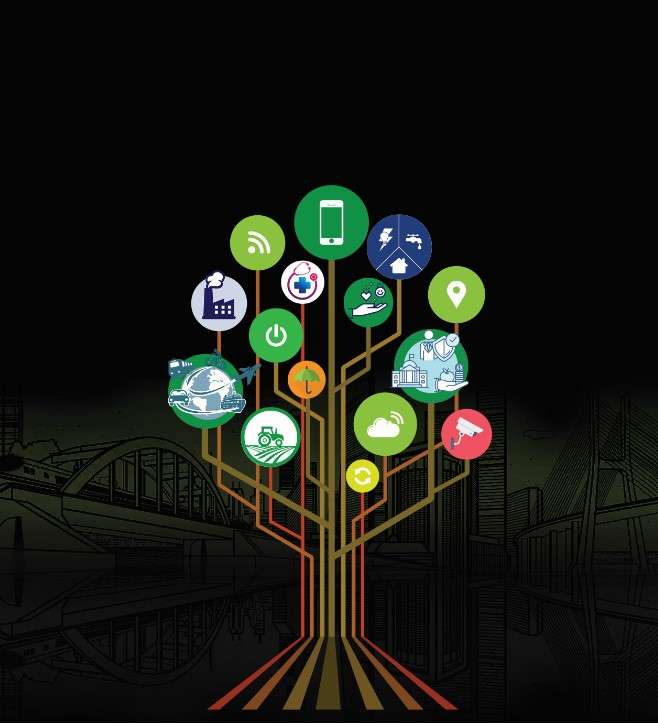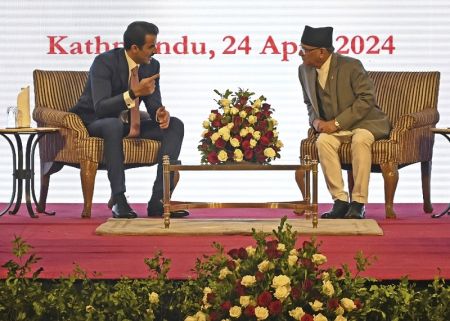The Fourth Industrial Revolution is reshaping economic, social, cultural and individual lives. Digital technologies and innovations are transforming the global economy, but Nepal is struggling to make sense on how it can benefit from these new trends
Parcels could literally land on your doorstep sooner than you might think as a drone is now being tested to transport cargo. It is expected to fly into action in early 2024. Though Uber is known as the world's largest taxi company, it does not have its own taxi. Alibaba, one of the most valuable retailers, does not have inventory. Oyo, an Indian multinational hospitality chain of leased and franchised hotels, does not own a single hotel. These are some of the companies that command the highest valuations in the world. These companies, or others like them, now permeate the daily lives of almost every person.
Most of these companies have one interesting common feature: even though they provide services like transportation, cargo, hospitality or retail, they are tech companies. They call themselves companies or firms operating on tech platforms. Some of these are the snippets of some of the recent global trends that have been reshaping global industry and services.
The rapid advancement of information technology has significantly altered both the consumer and corporate environments in recent years. There has been an unprecedented change in the way people work, commute, communicate or make payments. This shift has not only made a profound impact on how businesses operate but also disrupted certain business models, supply chains and patterns of employment. The technological revolution has either decimated traditional businesses or prompted incumbents to adapt to the new reality. There is a growing consensus among economists and thinkers that technology will now drive the global economy. They say that the scale and scope of the transformation powered by the digital revolution will be unlike anything humanity has ever experienced.
Major mechanisation and innovation during the mid-18th and early 19th century drove global growth in the industrial revolution. The manufacturing sector boomed during this period which was powered by the major invention of the steam engine. The creation of factories and booming textile industries is attributed to the invention of the steam engine during the first industrial revolution. The second industrial revolution was marked by the mass production and emergence of new industries like steel, oil and electricity. The light bulb, telephone and internal combustion engines were few major inventions of this era. The third industrial revolution occurred in the second half of the 20th century. In just a few decades, the world witnessed the invention of semiconductors, personal computers and the Internet. These breakthroughs, along with the previous industrial revolutions, contributed to the growth of agriculture as well as other sectors. Building on the advancements of the previous three industrial revolutions, the fourth revolution has been unfolding since the beginning of this new century.
This revolution also represents the “new economy” with a convergence of manufacturing, services and technologies to produce high value, technology-enabled, and adaptable industries. This new economy has many names. Some term it the sharing economy, while others call it the digital economy. For many, it is also known as the data economy, knowledge economy or gig economy. Whatever it is called, technological innovation is driving this new economic revolution. Experts predict that this new revolution is expected to transform individual’s lives, businesses’ operation and the global economy. They believe that it has the potential to unlock tremendous opportunities and create more opportunities for everyone.
There is probably not a single sector which has remained aloof from the recent technological revolution. It is only the matter of scale and scope. Many disruptive echnologies, including artificial intelligence, mobile Internet, autonomous vehicle, and advanced robotics, have the potential to upend the world. Other changes will support the advancement of incumbents.
In his book “The Fourth Industrial Revolution”, Klaus Schwab, the founder of the World Economic Forum (WEF), describes the fourth revolution as an era marked by a “technological revolution that is blurring the lines between the physical, digital, and biological spheres”.
But, how does this happen exactly?
Some of these disruptions are already apparent. There has been a marked shift in the way people book air tickets or cabs, purchase products or services, make or transfer payments, watch movies or play games. Similarly, business models are also changing. Now, thanks to the technological innovations and breakthroughs in recent decades or years, ordering a cab, booking a flight, buying a product, making a payment, listening to music, watching a film, or playing a game can all be done remotely.
Technologies like artificial intelligence, autonomous vehicles and the Internet of Things are becoming ingrained in day to day lives of many people around the world. One crucial characteristic that sets the new economy apart from previous industrial revolutions is that technology is increasingly merging with human lives. The speed and scale of technological changes are also unparalleled. For example, it took nearly 75 years for 100 million users to adopt the telephone, whereas Facebook signed up the same number of users in just four years. TikTok did it in about nine months. ChatGPT, the popular chatbot from OpenAI that generates articles, essays, jokes and even poetry in response to prompts, reached 100 million monthly active users in just two months of its launch.
Organisations are embracing new technologies to improve the efficiency of their businesses like they did with steam engines during the first industrial revolution. However, some companies and governments are struggling to keep up with the fast pace of technological changes. Researches have shown that innovators, investors and shareholders tend to benefit the most from innovations. Highly-skilled workers are rewarded with high pay and the rest of the workers are left out. Studies show that technologies like AI will eliminate some jobs and create demand for new skills that many workers don’t have. Privacy concerns are another issue as the new economy is driving every company into a tech company. Industries from food to retail to banking are all going digital and collecting a large volume of data from customers. This is making consumers increasingly uncomfortable as they feel their private digital life is being invaded.
Nepal’s readiness
While the tech is changing fast every day, Nepal appears to be somewhat isolated from this global trend. However, that does not mean the country is completely unaware about all this. Some sectors are already preparing for these changes, with both companies and customers attempting to adapt to the new techno-economic paradigm. Albeit slowly, they are striving to benefit from the opportunities unleashed by digital innovations around the world.
Though Nepal can contribute little to technological breakthroughs and innovations, it can still position itself to benefit most from it. Most of the economists agree that industrialisation has failed to take off in Nepal. Even when the world witnessed remarkable progress during the past industrial revolutions, Nepal missed the boat on industrialisation. It cannot afford to miss out on the opportunities offered by the fourth industrial revolution. If Nepal fails to prepare to adapt or respond to these structural changes, the country will continue to be stuck in poverty, suffer in its competitiveness, and be on the wrong side of the digital divide.
Kewal Prasad Bhandari, Secretary at the National Planning Commission (NPC), also agrees that the government should take significant steps so that it is in the position to leverage the new digital technologies for the development and growth. “The government is aware of this new trend. Most of these are the outcome of the innovations within and outside the country. So, they should be viewed and dealt with differently,” said Bhandari. “However, we have not been able to take any significant steps or approach to regulate or facilitate them, as we are all still obsessed with the conventional economy and the businesses that have supported it.”
Leapfrogging
But, is it really possible to catch up with the pace of global development? Economists say that there are ways for latecomer economies to do so by skipping some of the intermediate stages of industrialisation. According to them, such latecomers can ‘leapfrog’ directly into using more advanced technologies, as the traditional route may no longer be available for them. They cite the rapid adoption of cellular phone technology in some countries which had failed to achieve widespread landline coverage. Same could be applied to the adoption of recent technological advancements. Additionally, countries that have weak manufacturing bases can explore alternative strategies such as focusing on start-ups or service-based technologies. Rather than opting for mass-based production, start-ups prioritise smart factories that embrace automation, create entirely new products or adopt and improve existing products.
Interestingly, it’s not just traditional businesses or industrial giants that are on the forefront of this techno-economic paradigm. Entrepreneurship and innovation have become more affordable, and start-ups have challenged the dominance of big firms by disrupting traditional business and creating new industries.
Nepal has some strengths that can support its journey towards embracing this paradigm. The first and foremost is its demographics. Young people are quick to adopt new technologies as consumers, and most of the technological innovations and solutions are developed by young innovators and entrepreneurs. In Nepal, young people (16-25 years) account for approximately while 40.68% percent of the population lies in the age group of 16-40 years. The median age is 25 years.
This young population can innovate, launch businesses and create new opportunities. Some of the innovative solutions introduced and implemented come from young Nepali innovators. They already form a sizable share in Nepal’s gig economy.
While there is no study or data on the foreign currency earnings made by gig workers or freelancers, some estimates suggest the figure could be as high as Rs 10 billion per year.
This amount is nearly equivalent to the one tenth of total merchandise exports of the country. Despite years of initiatives to promote exports of various commodities by identifying them in the Nepal Trade Integration Strategy (NTIS), the total value of merchandise export touched the Rs 100-billion mark rupees only recently. However, this service sector of the new economy has fetched the country more. According to economists, Nepal should prioritise this new export sector which has the potential to boost the foreign exchange reserve of the country when the manufacturing sector is on a decline.
Gagan Thapa, a member of the House of Representatives, believes that new global trends have the potential to reshape businesses, economic activities as well as the individual behaviours. Stating that these innovations have already started to enter Nepal as evident in the growing number of gig workers, Thapa calls for creating an enabling environment to benefit from these global trends.
“The knowledge economy is emerging as a big sector. But, how does the government see it? How can we benefit from this? The young generation wants to be part of that economy. We can see this generation getting integrated with the new economy,” Thapa, who is also a general secretary of Nepali Congress, says. “The government and other institutions should also be prepared for that so that we are not left behind again.”
Adoption
Some government agencies or stakeholders, however, are at least trying to make sense of the emerging trend and technologies that are driving the new economy. These efforts may seem small, but the directions they are taking are encouraging. For example, the Nepal Rastra Bank (NRB) has taken steps towards issuing digital currency.
The central bank has initiated a feasibility study on the adoption of the central bank digital currency (CBDC) and has come up with a report. This initiative can be seen as the central bank’s preparation to issue the CBDC, a digital currency that is expected to substitute physical cash in the future. NRB’s preparations put Nepal ahead of the curve in exploring the feasibility and issuance of digital currency.
As of March 1, 65 countries are in the advanced stage of development of CBDC, and over 20 central banks, including Brazil, Japan and Russia, have launched their pilots.
The adoption of digital currency will change the concept of money. It will not be just limited to cash and coins. It is expected to revolutionise the way payments are initiated and made. Experts believe that CBDC will be a faster, easier, and more secure way for people to make payments compared to physical money. Moreover, it is expected to increase financial inclusion. Policy makers are also convinced that digital currency could achieve much cheaper, instantaneous domestic and cross-border payments. This new technology can democratise finance and benefit people in developing countries by broadening access to financial products and services.
“We have explored the key policy goals that could motivate NRB for adopting CBDC and recommend appropriate design choices for Nepal,” says Revati Prasad Nepal, an executive director of the NRB. “This report also recommends important ways forward for development and management of the CBDC ecosystem in Nepal in a successful way,” he adds.
Among others, the study recommends developing a prototype CBDC initially with the help of domestic developers, consultants, and system experts, and simulating such a CBDC in a closely controlled environment before developing and launching a real one which helps rightly design, develop, and implement the final CBDC.
Central banks around the world are rushing to explore the possibility of the digital currency in response to the proliferation of private digital currencies or cryptocurrencies that run on a distributed public ledger called blockchain. Blockchain is a record of all transactions updated and held by currency holders.
The growing interest in privately issued digital assets has led central banks around the world to explore the feasibility of digital currencies. The decline in cash usage, growing investment in crypto assets and the potential of cryptocurrencies to become a mainstream form of payment have prompted central banks to launch their own digital currencies. According to various studies, 10% of adults report holding or having held a digital asset, like cryptocurrency, in the United Kingdom. The European Central Bank says that as many as 10% of households in six large EU countries own digital assets. Despite a ban on crypto transactions or owning any such currency in Nepal, it is believed that many people, particularly youth and those residing abroad, have made significant investments on crypto assets including the most popular cryptocurrency Bitcoin.
Similarly, there are some other crucial sectors where digital technology is taking roots in Nepal. Agriculture sector is one among them. As agriculture by far is the largest sector of the economy, experts say that digital technologies are a must to maximise production, anticipate weather patterns and monitor crop health.
Digital technologies can not only help in increasing efficiency, productivity and sustainability of small-scale farms, but help to push the overall contribution of agriculture in the country’s GDP. In recent years, the contribution of the agriculture sector to GDP has been declining with the sector contributing only 24.67% in the previous fiscal year 2021/22, down from 32.68% in 2011/12. The adoption of digital technologies could significantly increase production and support the overall economy of the country. Even small-scale adoption of technology such as mobile applications, remote-sensing services and weather forecasts are improving farmers’ access to information, inputs and markets, thereby increasing production and productivity.
Agricultural experts suggest that Nepal can benefit by adopting digital technologies in various areas of the agriculture sector. For instance, the government can disburse subsidies digitally and support the development of smart irrigation and livestock management projects. Tele-veterinary facilities could be made available to farmers. Similarly, agriculture product quality tracking systems can also help improve crop yields and productivity.
Although sophisticated technologies such as farm management apps, milking robots, self-driving tractors or soil disease detection drones may be far-fetched ideas for farmers in Nepal, there are some digital platforms which are providing information on crop management, pest and livestock management, soil nutrient, and weather information. The Covid-19 pandemic accelerated the adoption of some of these initiatives.
In recent years, precision agronomics has emerged as a promising approach to improve farming techniques for planting and growing crops. Variable rate technology (VRT), GPS soil sampling and remote sensing technology are some of the core elements of precision agronomics. While it may take some time for Nepal to adopt these advanced technologies, the country can start by embracing some initial forms of precision agronomic or taking initiatives to create an enabling environment. The National Statistics Office (NSO) has made some efforts to collect and visualise data using GIS. However, it does not provide real-time data.
Risks abound
While the new economy offers various benefits such as increased speed, agility, efficiency, and profitability, the digital technologies behind it also pose certain risks. One of the most significant risks is cybersecurity risk. There are also risks of third-party breaches. Moreover, data privacy is also a concern. Some of these risks have already become evident.
Such threats could not only cause huge financial losses to individuals, businesses, and governments, but also risk shutting the operation and services even in the sensitive and critical areas like healthcare, telecommunication, aviation and banking, among others.
According to Nepal Police, they are observing an increase in the number of data breach cases. The banking sector in particular has been hit by cyberattacks in recent years. From the SWIFT-related heist in NIC Asia Bank in 2017 to hacking of nearly Rs 19 million from ATMs by Chinese nationals, there is a rise in the cases that expose the digital vulnerability. The law enforcement agency seems to be largely under-prepared or ill-equipped to address these new risks. However, Nepal Police Spokesperson Kuber Kadayat says that the police have the capacity to deal with the cyberattacks and other risks emanating from the growing use of digital technologies.
“Nepal Police always remains alert against digital threats. We have been able to crack down on cybercrimes,” says Kadayat. “As we have recognised the digital threat as one of the major risks with the growing adoption of technologies, we are also strengthening our cyber bureau.”
Not only the private sector organisations, but the government is also susceptible to risks arising from the adoption of digital technologies. In January, the Government Integrated Data Centre, which is the government’s main server, was subject to cyberattacks aimed at shutting it down. The intrusion resulted in hundreds of government sites going offline, including the immigration server, which impacted international travel. These incidents expose the vulnerabilities of the government’s digital infrastructure.






















